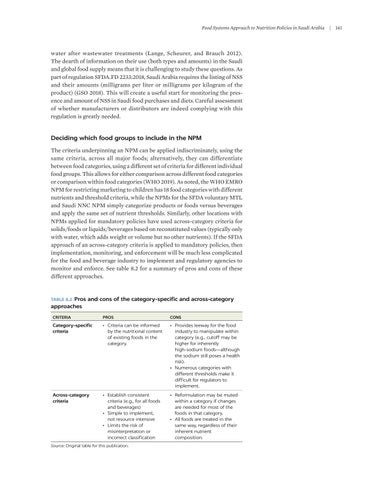Food Systems Approach to Nutrition Policies in Saudi Arabia
water after wastewater treatments (Lange, Scheurer, and Brauch 2012). The dearth of information on their use (both types and amounts) in the Saudi and global food supply means that it is challenging to study these questions. As part of regulation SFDA.FD 2233:2018, Saudi Arabia requires the listing of NSS and their amounts (milligrams per liter or milligrams per kilogram of the product) (GSO 2018). This will create a useful start for monitoring the presence and amount of NSS in Saudi food purchases and diets. Careful assessment of whether manufacturers or distributors are indeed complying with this regulation is greatly needed.
Deciding which food groups to include in the NPM The criteria underpinning an NPM can be applied indiscriminately, using the same criteria, across all major foods; alternatively, they can differentiate between food categories, using a different set of criteria for different individual food groups. This allows for either comparison across different food categories or comparison within food categories (WHO 2019). As noted, the WHO EMRO NPM for restricting marketing to children has 18 food categories with different nutrients and threshold criteria, while the NPMs for the SFDA voluntary MTL and Saudi NNC NPM simply categorize products or foods versus beverages and apply the same set of nutrient thresholds. Similarly, other locations with NPMs applied for mandatory policies have used across-category criteria for solids/foods or liquids/beverages based on reconstituted values (typically only with water, which adds weight or volume but no other nutrients). If the SFDA approach of an across-category criteria is applied to mandatory policies, then implementation, monitoring, and enforcement will be much less complicated for the food and beverage industry to implement and regulatory agencies to monitor and enforce. See table 8.2 for a summary of pros and cons of these different approaches.
TABLE 8.2 Pros and cons of the category-specific and across-category approaches CRITERIA
PROS
CONS
Category-specific criteria
• Criteria can be informed by the nutritional content of existing foods in the category.
• Provides leeway for the food industry to manipulate within category (e.g., cutoff may be higher for inherently high-sodium foods—although the sodium still poses a health risk). • Numerous categories with different thresholds make it difficult for regulators to implement.
Across-category criteria
• Establish consistent criteria (e.g., for all foods and beverages) • Simple to implement, not resource intensive • Limits the risk of misinterpretation or incorrect classification
• Reformulation may be muted within a category if changes are needed for most of the foods in that category. • All foods are treated in the same way, regardless of their inherent nutrient composition.
Source: Original table for this publication.
|
141






